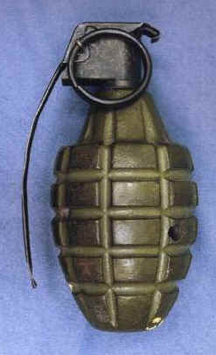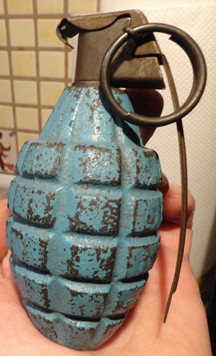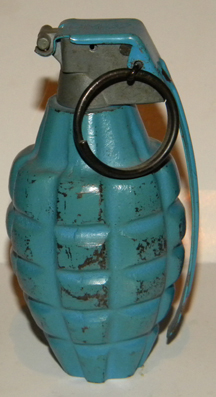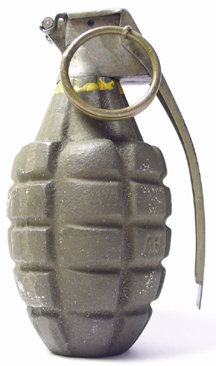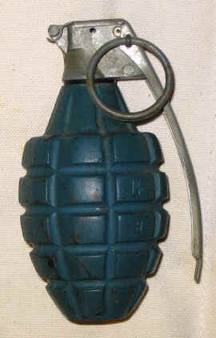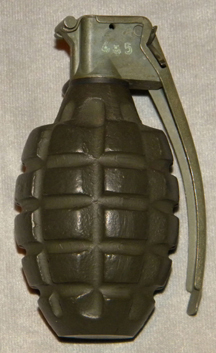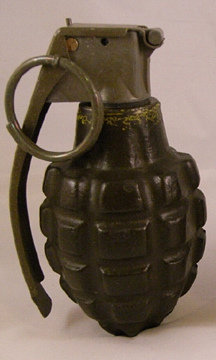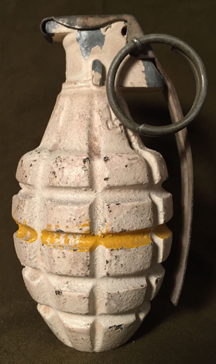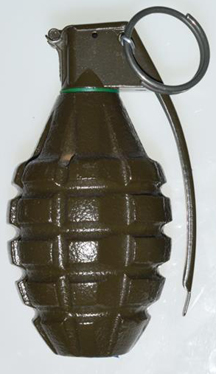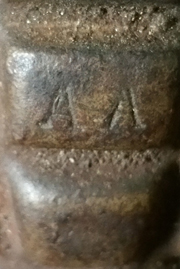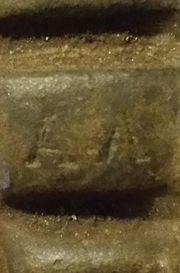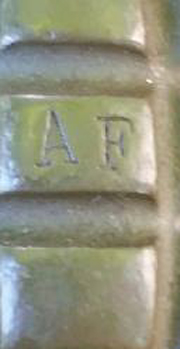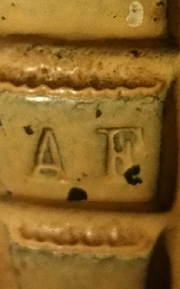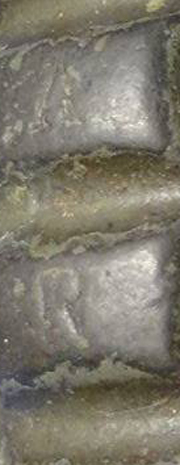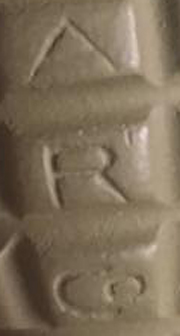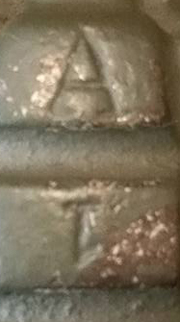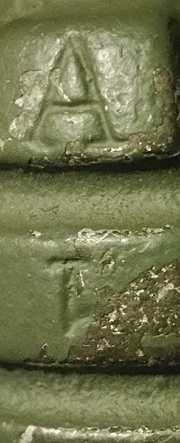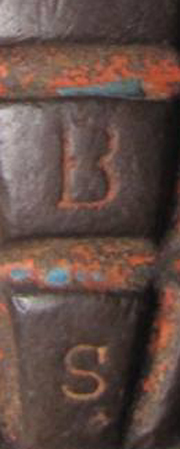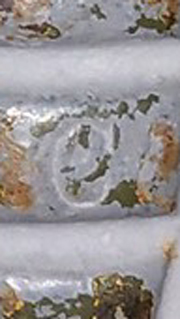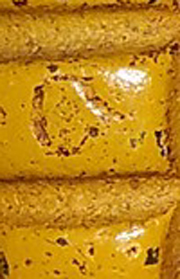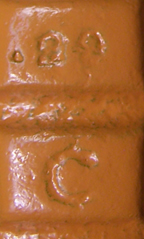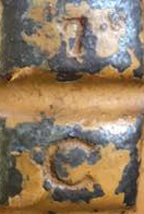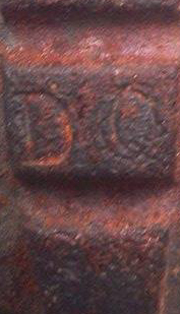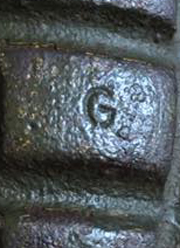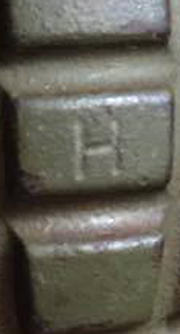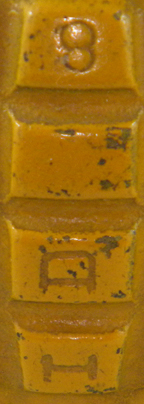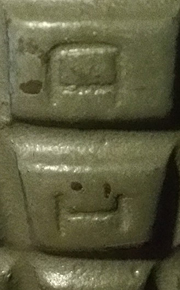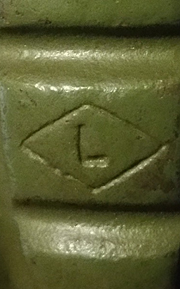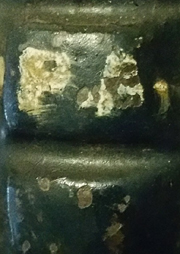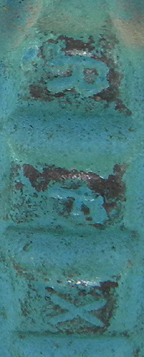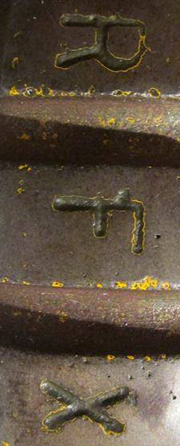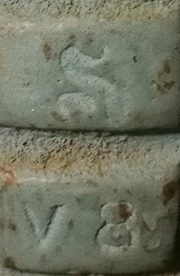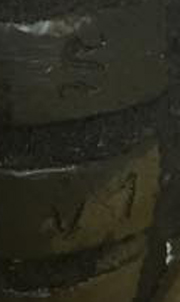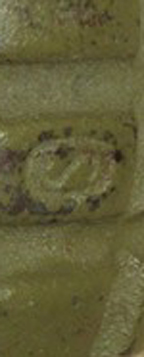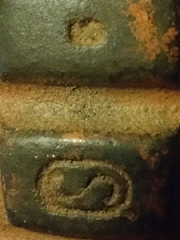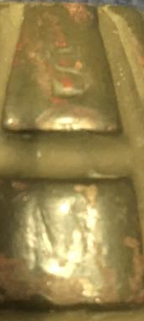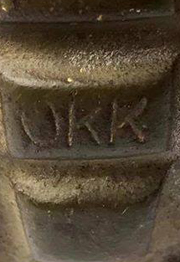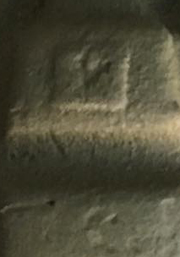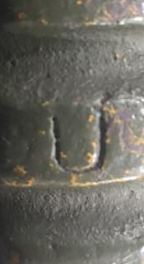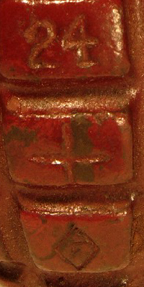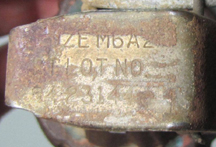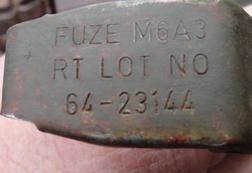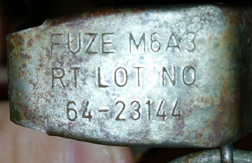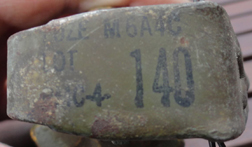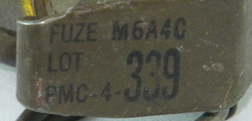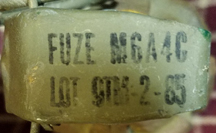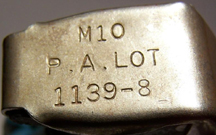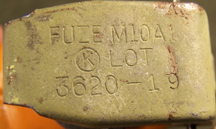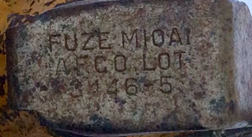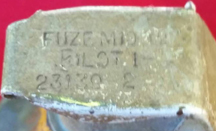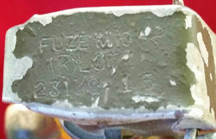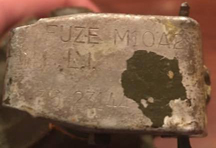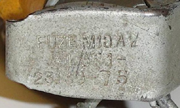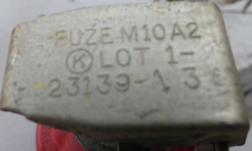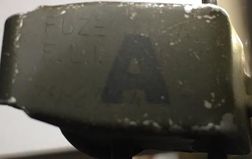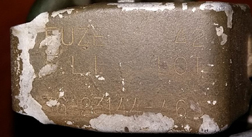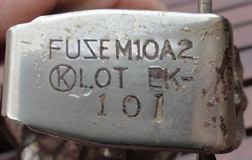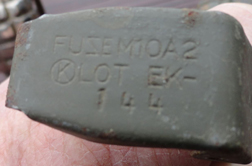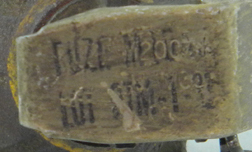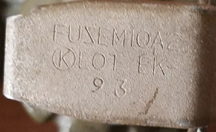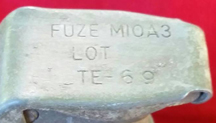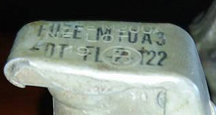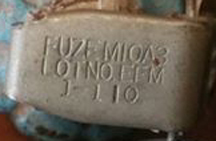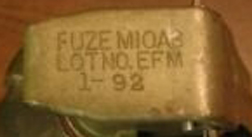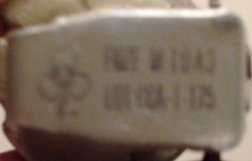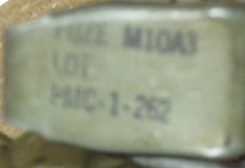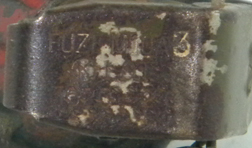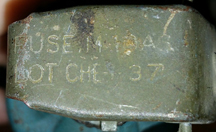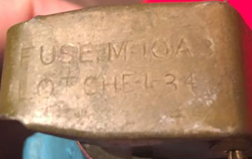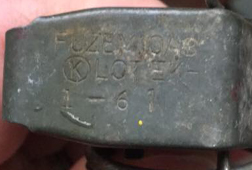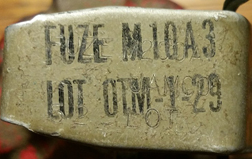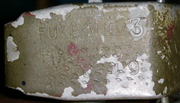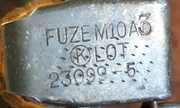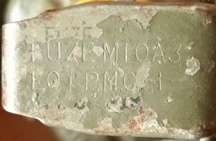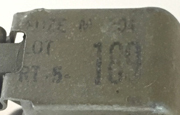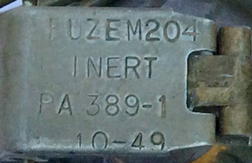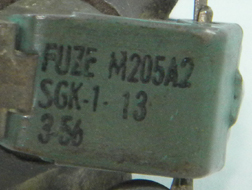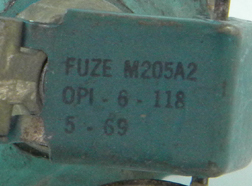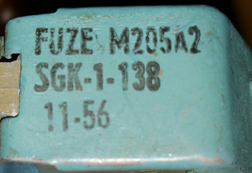When the Mk. I grenade was
condemned by the AEF in May of 1918 the Americans were again without a
defensive grenade of their own.
With an offensive planned for the spring of 1919 it was
imperative that a new grenade be designed and produced without delay.
American industry proved to be up to the task and by August 1,
1918 had the new grenade designed and much of the required machinery
produced and installed.
Initial orders called for 44 million grenades.
A daily production figure between 250,000 and 300,000 was
achieved by November 11, 1918.
Over 21 million were produced by December 6, 1918.
According to records only 516,533 had been shipped overseas.
Companies involved in producing grenades or parts were: Spacke
Machine & Tool Co., Stewart-Warner Speedometer Co., American Radiator
Co., International Harvester Co., Miami Cycle & Manufacturing Co.,
Doehler Die Castings and Precision Casting Co.
The new grenade was favorably
accepted by the AEF and became the standard American fragmentation
grenade. This grenade was
used for a number of years after the war and was likely supplied to
allied countries such as the Philippines.
An account of an action on
The Mk. II grenade has gone
through many modifications since 1918.
It is difficult to pin down exactly when particular modifications
were made. There have been
changes to the body, filling changes, many fuze changes and colour
changes in its career with many of the changes overlapping.
The bodies are quite varied,
depending on manufacturer, but there seems to be four main types of
body. The first body which
is not included in the four, was that of the Mk. I grenade.
Period manuals seem to indicate that when the fuze mechanism was
modified to the Mk. II style, some use at least was made of the surplus
Mk. I bodies with the new fuze mechanism.
That use may only have been as practice grenades.
The first truly Mk. II body was
designed in 1918. Made of
cast iron it is about 2.25 inches diameter and 3.5 inches high.
The lower portion of the body is divided into 40 segments (8
vertical rows of 5). The bottom
is drilled and tapped to form a 3/8” filling hole closed by an aluminum
alloy filling plug. The
body tapers toward the filling hole leaving only a thin rim between the
outside of the body and hole.
The upper cone is divided along the same vertical lines as the
body. The transition
shoulder from the cone to main body is quite rounded.
The body at the top of the cone is threaded to accept the fuze
mechanism. The body may be
marked with the manufacturers mark on one of the segments and may have a
mold number on it.
Defensive Grenade, Mk. II
Igniter- Bouchon and Detonator
Assembly Mk. II
 |
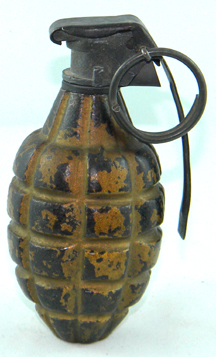 |
Fragmentation Hand Grenade H.E.
Mk. II
Igniter- M5
After July 1925 the grenade was
redesignated as “Grenade Hand,
Fragmentation, HE Mk. II” to conform to new nomenclature standards.
This grenade uses the first or second body type and is fitted
with “Detonating Hand Grenade Fuze M5”.
The body is filled with 1.85 oz. of loose granular TNT.
This grenade was used through the 1920’s to the early 1940’s.
The grenade body is painted
yellow. The fuze mechanism
is unpainted.
The filled grenade bodies were
issued separately from the fuze mechanisms.
24 grenades were packed in a box with the grenades separated by
spacers. The grenades were
shipped with a wooden plug screwed into fuze hole.
The wooden plug extends into the body and when withdrawn leaves a
cavity in the explosive for the detonator.
The fuze mechanisms were packed 384 to a wooden crate.
A spanner wrench was included with each box of fuzes to be used
to firmly seat the fuze into the grenade.
Grenades were fuzed just prior to use.
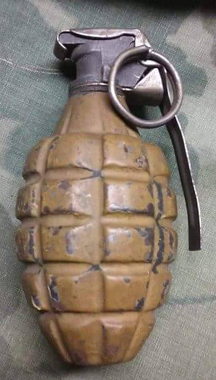
Grenade, Hand, Fragmentation,
Mk.II
Igniter- M10, M10A1, or M10A2
This grenade used body type 2
and later body type 3. The
grenade with a filling of EC blank fire powder was adopted as standard
on Oct 21, 1926. It was
initially fitted with the M10 igniting fuze with a short lever.
In 1930 the lever was extended to 4 inches to make the grenades
safer to handle. In early
1942 the igniter mechanism was changed to the M10A1 and in late 1942 to
the M10A2. The body was
filled with 0.74 oz of EC Blank fire powder.
Declared limited standard in 1943.
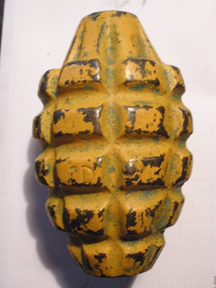
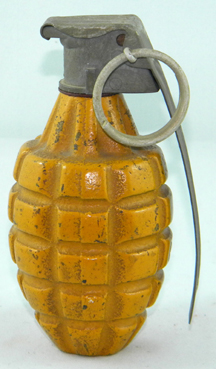
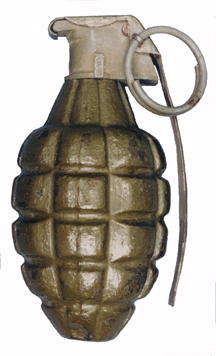

Grenade, Hand, Fragmentation, Mk.
IIA1
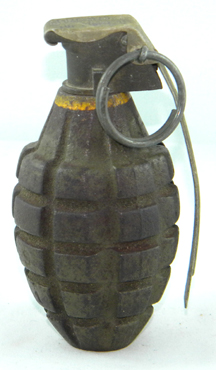
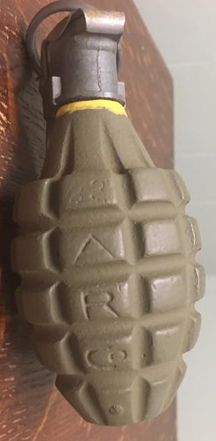
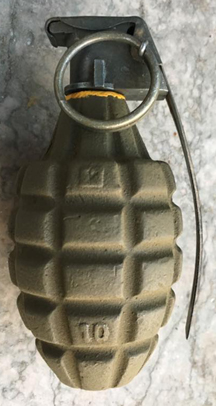
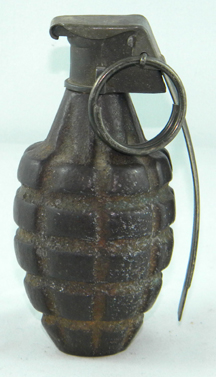
Grenade, Hand, Fragmentation,
TNT, Mk. II
Igniter- M6A4C, M204, M204A1,
M204A2
Testing of the grenades in use
concluded that fragmentation grenades loaded with TNT produced more
fragments that were projected at higher velocities to greater distances
than grenades loaded with EC Blank fire powder.
As a result, new grenades were to be loaded with 2 ounces of TNT.
These grenades normally used the fourth body type without filling
hole. They were fitted with
the Fuze, Detonating Hand Grenade M6A4C.
The grenades were later fitted with the M204 series of fuze
mechanism. This grenade became standard in April 1944 and continued in
use until replaced by the M26.
Large quantities remained on hand and were used throughout Korea
and into the conflict in Vietnam.
The grenades were painted Olive green
with a yellow band around the top of the body.
The fuze mechanism is marked on the top of the lever with the
designation and lot number.
The grenades were packed in
boxes containing 25 grenades complete with fuzes.
Each grenade is individually packed in the M41 fiber container
which prevented sympathetic detonation.
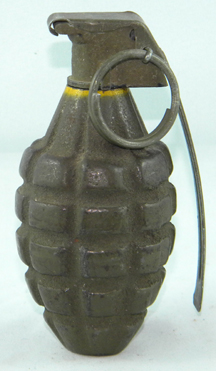 |
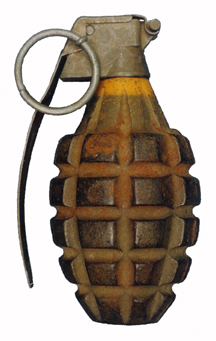 |
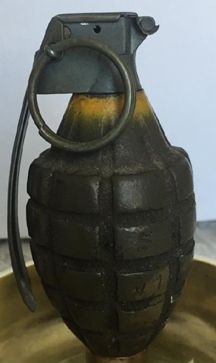 |
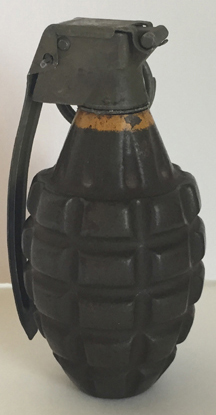 |
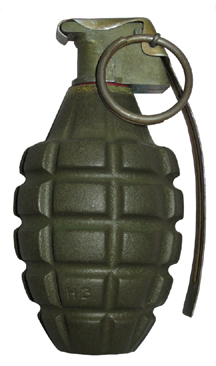 |
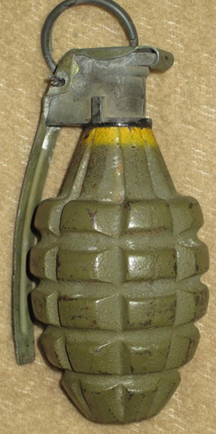 |
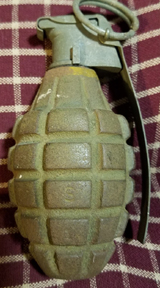 |
Mk. II Practice Grenades
During the First World War when
the Mk. II was first developed, in addition to the 17 million defensive
grenades produced to Nov. 8 1918, they also produced 3.6 million
practice grenades and 415 thousand dummy grenades.
“Americas Munitions” does not indicate whether the practice
grenades were Mk. II or Mk. I grenades.
The Manual for Hand Bombers of July 1918 mentions practice
grenades under the Mk. I section, but no mention is made in the section
on the Mk. II. The manual
describes the practice grenades as being similar in every way to the
live grenade but omitting the explosive charge, detonator, fuze and
filling hole plug. This
indicates that the practice grenades of the first war and immediately
after were more of an instructional type grenade rather than the
practice grenade as it later became.
It is likely that Mk. I bodies were utilized with the fuze
mechanisms changed to the Mk. II type to stay current with the live
grenades in service. It is
also likely that some Mk. II bodies were also utilized.
In the standards of the time, these grenades were painted red.
Grenade, Hand, Practice, Empty,
Mk. II
Igniter- Mk II, M5
The first version introduced
into use utilized the standard body and the Mk. II Bouchon assembly with
No. 6 detonator. The filling
hole was closed by a cork.
Believed to have been first introduced in the 1924-25 period.
The body was painted red at this point.
When the colour changes were made in 1926 it is likely the colour
of the practice grenades was also changed from red to blue.
The use of the Bouchon Assembly Mk. II with No. 6 Detonator
continued in use until at least 1936.
At that time it was obsolete for future manufacture having been
replaced by the M5 and later the M10 fuze mechanisms but as stocks
remained it was to be used for practice until exhausted.
The No. 6 detonator provided a loud report with a bit of smoke.
Sometime between 1930 and 1936 this version was declared limited
standard.
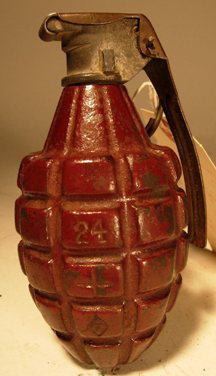
Grenade, Hand, Practice, Mk. II
Igniter- M10, M10A1, or M10A2
This version used a standard body with
the “Hand Grenade Igniting Fuze M10”.
Due to the use of an igniting fuze rather than one with a
detonator a practice charge is required to provide a loud report and
small puff of smoke. The
practice charge contains 22 grains of black powder pressed into pellet
form. The practice charge is
contained in the lower end of a paper tube 1/16 inch in diameter and
1.25 inches long. The bottom
of the tube is closed with a chipboard disc with a similar disc inside
the tube on top of the charge.
When the grenade is fired, the
practice charge blows the cork out, produces a loud report and a puff of
white smoke.
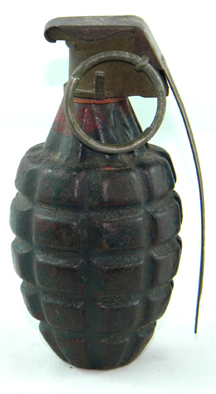
Grenade, Hand, Practice, Mk 2A1
This is a little known version
of the practice grenade. Not
listed in any of the manuals it can only be assumed that its service
life was extremely short. It
is noted as using the M10A3 igniting fuze.
It is likely that this grenade was redesignated as the M21
grenade to prevent confusion in supply.
Grenade,
Hand, Practice, M21
Igniter- M10A2, M10A3, M205, M205A1,
M205A2
It appears that the M21 grenade was designated in 1943/44.
Most likely it was simply a redesignation of the Mk. 2 and Mk.
2A1 practice grenades to prevent errors in supply.
Having grenades designated similarly could cause problems when
ordered from supply.
``Grenade, Hand, Fragmentation Mk. 2`` and ``Grenade, Hand, Practice,
Mk. 2`` were too similar and the most effective way to prevent the
errors was to have a completely different designation.
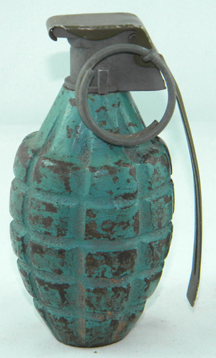 |
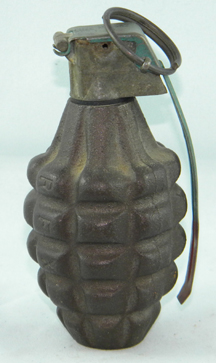 |
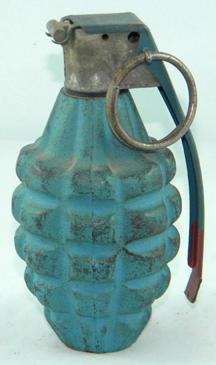 |
